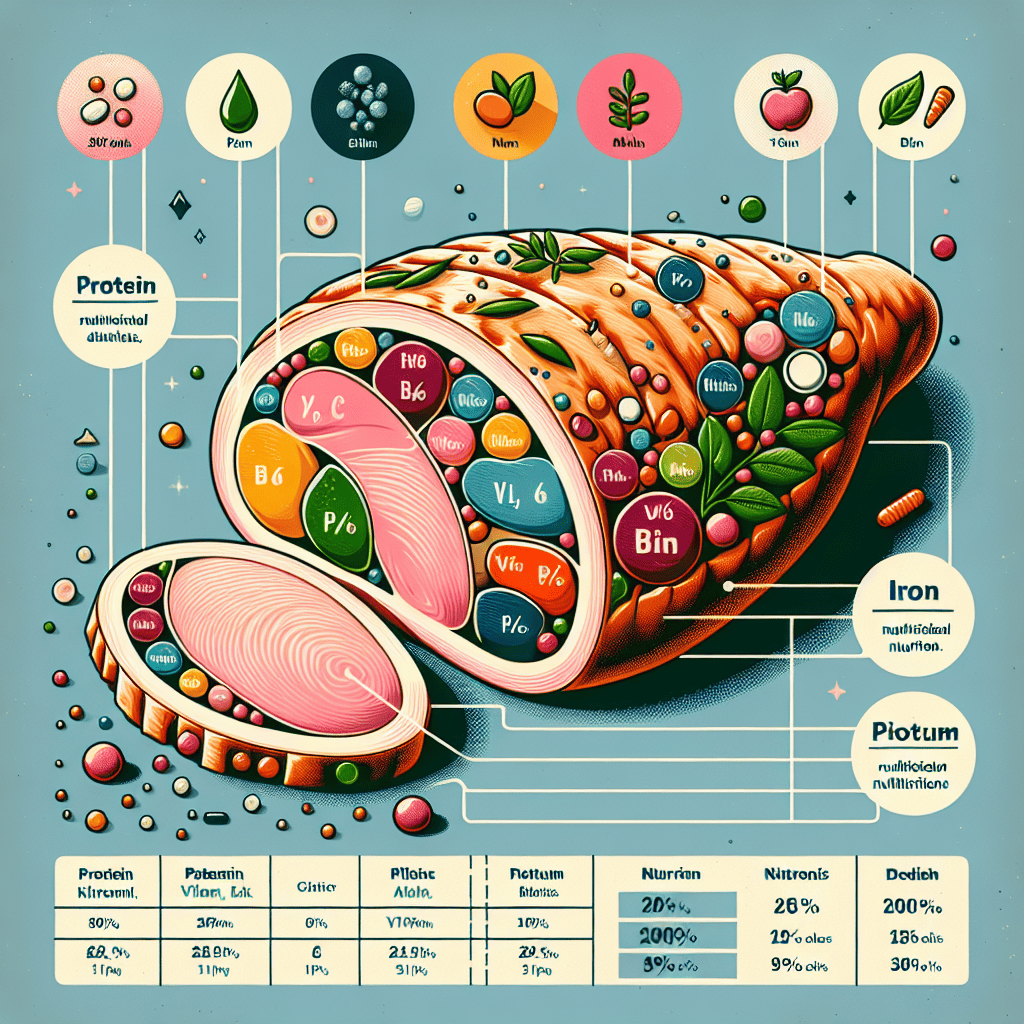Introduction: Chicken breasts are a popular choice for a healthy, protein-rich meal. However, understanding the nutritional variances between chicken breasts with skin and without, as well as the impact of various cooking methods, is essential for making informed dietary decisions. This blog post delves into the comparison of the nutritional content of different chicken breast preparations to help you make healthier choices.
Table of Contents
The Nutritional Value of Chicken Breasts with Skin
This section will delve into the nutritional value of chicken breasts with skin.
- Nutritional Content of Chicken Breasts with Skin:
When it comes to chicken breasts, the presence of the skin significantly affects its fat and caloric content. The skin of the chicken acts as a reservoir of fat, which when cooked gets infused into the meat, increasing the overall fat content. This fat content contributes to the caloric value of the chicken as fat is a calorie-dense macronutrient. Therefore, opting for skinless chicken breasts can be a healthier choice for individuals who are conscious of their fat and calorie intake.
Removing the skin from chicken breasts not only reduces the fat and calorie content but also makes the meat leaner. Skinless chicken breasts are a popular choice among health-conscious individuals and those watching their weight due to their lower fat content. They are a good source of lean protein, making them a staple in many healthy diets. Additionally, cooking methods such as grilling, baking, or poaching skinless chicken breasts can further enhance their nutritional profile by keeping the calorie and fat content low.
It’s important for people to be mindful of their dietary choices, especially when it comes to protein sources like chicken. While the skin may add flavor and moisture to the meat, it also adds excess calories and fat. By choosing skinless chicken breasts, individuals can enjoy a lean and nutritious protein source without compromising on taste. Pairing skinless chicken breasts with a variety of vegetables, grains, and healthy fats can help create a well-rounded and balanced meal that is not only delicious but also supports overall health and well-being.
The Nutritional Value of Chicken Breasts without Skin
This section will explore the nutritional value of skinless chicken breasts.
- Comparison of Skinless Chicken Breasts:
Skinless chicken breasts are a popular choice for those looking to reduce their fat and calorie intake. By removing the skin, you can significantly lower the fat content of the chicken. The skin of the chicken contains a high amount of fat, and by discarding it, you are essentially eliminating a portion of the fat that would otherwise be consumed. This makes skinless chicken breasts a leaner protein option compared to skin-on chicken, which can be beneficial for individuals watching their weight or trying to maintain a healthier diet.
Furthermore, by opting for skinless chicken breasts, you not only reduce the fat content but also decrease the overall calorie count. Since fat is a calorie-dense nutrient, removing the skin helps in reducing the total number of calories in the chicken. This can be particularly advantageous for individuals who are on a calorie-restricted diet or aiming to create a calorie deficit for weight loss purposes. Skinless chicken breasts are a nutritious and satisfying protein source that can aid in maintaining a balanced diet while keeping the calorie intake in check.
In addition to being lower in fat and calories, skinless chicken breasts are versatile and easy to prepare. They can be grilled, baked, roasted, or sautéed, allowing for a variety of cooking methods to suit different preferences and culinary styles. Skinless chicken breasts also serve as a blank canvas for various seasonings, marinades, and sauces, making it a versatile ingredient that can be incorporated into numerous dishes. Whether you are following a specific dietary plan or simply looking for a healthy protein option, skinless chicken breasts offer a lean and nutritious choice that can be enjoyed in a multitude of ways.
The Nutritional Value of Frozen Chicken Breasts
This section will discuss the nutritional content of frozen chicken breasts.
- Nutritional Composition of Frozen Chicken Breasts:
When purchasing frozen chicken breasts, it is crucial to pay attention to the nutritional content and ingredients list on the packaging. Some frozen chicken products may contain added preservatives, sodium, or other additives that can impact the overall healthiness of the meat. For example, some manufacturers may inject chicken breasts with a solution containing salt and other flavorings to enhance taste and texture. While these additives may make the chicken more flavorful, they can also increase the sodium content and potentially add hidden calories.
Furthermore, the processing method can also affect the nutritional value of frozen chicken breasts. Some products may undergo heavy processing, which can strip the meat of nutrients and diminish its overall quality. Look for frozen chicken breasts that are minimally processed to retain as many nutrients as possible. Opting for organic or free-range options can also ensure that the chickens were raised without antibiotics or hormones, producing a healthier and more natural product.
In conclusion, while frozen chicken breasts can be a convenient and versatile protein source, it is important to be mindful of the ingredients and processing methods used. By reading labels carefully and choosing products with minimal additives and processing, you can enjoy the nutritional benefits of frozen chicken without compromising your health. Additionally, opting for organic or free-range options can provide a higher quality product with potentially more nutrients and fewer harmful substances, allowing you to make healthier choices for you and your family.
The Nutritional Value of Grilled Chicken Breasts
This section will analyze the nutritional value of grilled chicken breasts.
- Nutritional Content of Grilled Chicken Breasts:
Grilled chicken breasts have become a popular choice for health-conscious individuals due to their lower fat content in comparison to fried alternatives. When chicken is grilled, the excess fat drips off the meat, resulting in a leaner dish that is lower in calories. This cooking method also helps retain more of the chicken’s natural juices, keeping it moist and flavorful without the need for additional fats or oils.
Aside from being a healthier option, grilled chicken breasts are also a versatile and delicious choice for meals. The smoky flavor that grilling imparts on the chicken enhances its taste and adds depth to the dish. The seasoning and marinades used before grilling can further elevate the flavor profile, allowing for a variety of culinary possibilities and taste experiences. Grilled chicken breasts can be enjoyed on their own, sliced into salads, sandwiches, or wraps, or paired with a side of vegetables for a well-rounded meal.
In addition to being a tasty and nutritious option, grilling chicken breasts is a convenient cooking method that can save time in the kitchen. Grilling is a quick and straightforward process that requires minimal preparation and cleanup, making it a practical choice for busy weeknights or casual gatherings. With a hot grill and properly seasoned chicken breasts, a flavorful and wholesome meal can be ready in a matter of minutes, making grilled chicken breasts an excellent choice for those looking for a balanced and hassle-free dining solution.
The Nutritional Value of Fried Chicken Breasts
This section will explore the nutritional value of fried chicken breasts.
- Comparison of Fried Chicken Breasts:
Fried chicken breasts are a popular dish that can be delicious but are also high in fat and calories, especially when prepared with the skin intact. When chicken is fried, it absorbs oil which increases its calorie content. Additionally, leaving the skin on adds extra fat. This can contribute to weight gain and might not be suitable for individuals trying to manage their weight or those with health conditions like high cholesterol or heart disease.
Moderation is key when including fried chicken breasts in your diet. While it’s okay to enjoy this indulgent meal occasionally, it’s vital to balance it with healthier options to maintain an overall healthy diet and lifestyle. You can consider healthier cooking methods for chicken breasts such as baking, grilling, or poaching, which reduce the amount of added fats and calories compared to frying. Removing the skin before cooking can also make a significant difference in the fat content of the dish.
To offset the higher fat and calorie content of fried chicken breasts, consider pairing it with a side of fresh vegetables, whole grains, or a salad to add fiber, vitamins, and minerals to your meal. This can help increase the nutritional value of your dish and create a more balanced plate. It’s also recommended to pay attention to portion sizes when consuming fried foods to avoid overeating. By making mindful choices and being aware of the nutritional content of your meals, you can still enjoy fried chicken breasts as part of a varied and balanced diet.
The Nutritional Value of Boiled Chicken Breasts
This section will delve into the nutritional content of boiled chicken breasts.
- Nutritional Composition of Boiled Chicken Breasts:
Boiled chicken breasts are a popular choice for those looking for a healthy and low-calorie option. By boiling the chicken, you can preserve the natural flavors and nutrients of the meat as compared to other cooking methods that may involve added fats or oils. This method helps to keep the chicken moist and tender without the need for excessive added calories from cooking oils or butter. Additionally, boiling is a simple and straightforward cooking technique that requires minimal effort, making it a convenient option for quick and healthy meals.
High in protein, boiled chicken breasts are an excellent choice for individuals looking to increase their protein intake without consuming too many calories or unhealthy fats. Protein is essential for building and repairing tissues in the body, making it a crucial nutrient for overall health and muscle development. By incorporating boiled chicken breasts into your diet, you can benefit from a lean source of protein that can help you feel full and satisfied, making it a great option for weight management and overall well-being.
In addition to being a low-calorie and high-protein option, boiled chicken breasts are also versatile and can be used in a variety of dishes. Whether shredded and added to salads, sliced and placed in sandwiches, or diced and mixed into soups or stir-fries, boiled chicken breasts can be a nutritious and delicious addition to your meals. Furthermore, you can season the chicken with herbs, spices, or sauces to enhance its flavor without significantly increasing the calorie content. Overall, boiled chicken breasts offer a simple and healthy cooking option that can be a staple in a balanced diet.




